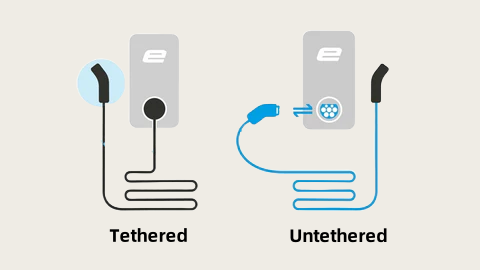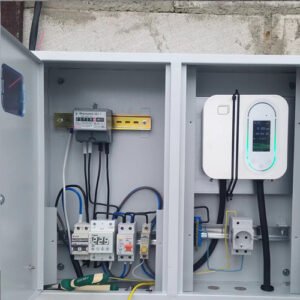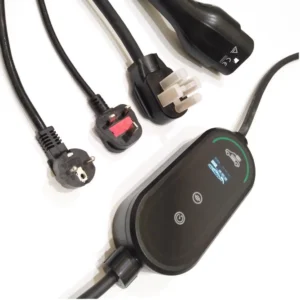definition of tethered EV chargers and untethered EV chargers
Tethered EV chargers feature a permanently fastened cable and offer a fixed connector (e.g., Type 1, Type 2, or GB/T).

Untethered EV chargers lack a fixed cable; users must provide their compatible cable, typically with a type2 socket (e.g., Type 2 to Type 2, Type2 to Type 1 ev charging cable).

What is a tethered EV charger ?
A tethered EV charger for electric cars is a wall-mounted charging box with a cable that plugs into your car. It has a Type 2 charging cable built into it, which means you don’t have to search for a charging cable every time you want to charge.
The EV charging cable, which is permanently attached to the EV charging pile, usually hangs on the Type 2 holder or Type 2 holster.
Advantages:
No spare cable needed to be prepared since it has a permanently attached cable to make it more user-friendly.

You don’t have to go through the extra step of loading the cable into the charging box before you can plug it into your electric car.
Disadvantages:
Flexibility:
Limited to specific cables and connectors:
If a Type 1 car wants to charge on a tethered EV home charger and then the EV owner needs to prepare an adapter by himself.
If the cable length is limited and then the EV owner needs to prepare an extension EV charging cable by himself.
Space Occupation:Tethered chargers take up more space than the unthered charger
Cost: The addition of a cable means that a tethered charger costs more than an untethered charger.
What is an untethered EV charger ?
An untethered EV charger is a wall-mounted charging box without a cable attached, while with a built in Type 2 socket, which is also normally called as a socket ev charger. It can be compatible with different EV since it has a socket that can be plugged into cables with different types of connectors.
Advantages:
Neat Design: No attached cable means it takes up less space, allowing for a sleeker design.
More economical: it was cheaper than a tethered EV home charger. If you already have a Type 2 to Type 2 charging cable, opting for a socket charger can save money.

Flexibility: You are free to change cables and connectors without having to replace the entire charger.
What’s the difference between these tethered and untethered ev charger?
Tethered EV chargers: A tethered EV home charger is a wall-mounted charging pile featuring a permanently fastened cable, which means the cable is an Inseparable part of the charger. In Europe, the previous permanently fastened cable is usually a Type 2 connector (which is the standard in Europe). So the EV owner is supposed to be there and open the lid of ev, plug and charge. (No spare parts need to be prepared.)
Untethered ev charger: An Untethered EV home charger is a wall-mounted charging pile featuring a socket inside, which means the cable is the independent part of the charger. In Europe, the previous socket is usually a Type 2 socket (which is the standard in Europe). Then EV owners need to prepare the ev charging cable by themselves.
To summarize, the main difference is the definition of the cable.
All-round comparison between tethered EV charger and untethered EV charger
Initial installation cost
Tethered charger: The price includes the cable,and the total cost is higher, but no additional accessories are required
Untethered charger: The unit price of the device is low (saving about 10%-20%), but users need to purchase a charging cable separately
Long-term maintenance costs
Tethered charger: Fixed cables are prone to aging due to long-term exposure (extreme weather accelerates the cracking of the rubber), and maintenance requires professionals
Untethered charger: The failure rate of the charging pile itself is low, and the user-provided cables can be replaced separately if damaged (cost controllable)
Multi-scenario Usage
Tethered charger: Most of them are designed for family/private parking spaces, exclusive to single car owners, and cables in public scenes are easily occupied or damaged.
Untethered charger: :Most of them are designed for public or commercial parking spaces thus One pile for multiple car sharing.
Safety Notification
Tethered charger: Fixed cables are easy for vandalism and require additional locks or monitoring (extra cost).
Untethered charger: The charging cable is taken away by the car owner, reducing the risk of the charging pile being stolen (especially in open-air parking lots)
Vehicle compatibility
Tethered charger: The cable interface is fixed (such as ICE 62196). If the interface does not match the vehicle, it needs to be modified or replaced.
Untethered charger: Supports multi-protocol EV, it is compatible with brands such as BYD, Tesla, Nissan Leaf, once the EV owner can prepare the EV charging cable by himself.
Upgrade
Tethered charger: The cable is integrated with the pile body, and upgrading requires the entire pile to be replaced (costly)
Untethered charger:Just change the charging cable to match different EVs.
Durability
Tethered charger: Cables are prone to bending and hardening of the rubber due to long-term hanging (they are prone to cracking due to low temperatures in winter in the north), and are exposed outdoors for a long time.
Untethered charger: The pile socket is designed with a protection level of IP54 or above, and the cables are kept by the user; users can choose different cables on the market according to their budget.
Which one is better ? tethered charger or untethered EV charger?
Choosing a tethered charger or an untethered charger depends on your preferences and needs. You can make a choice based on the above comparisons. In general, which charger to choose depends on your usage needs, charging frequency, cost considerations, vehicle replacement frequency, and convenience. I hope this article can help you choose a charger.








